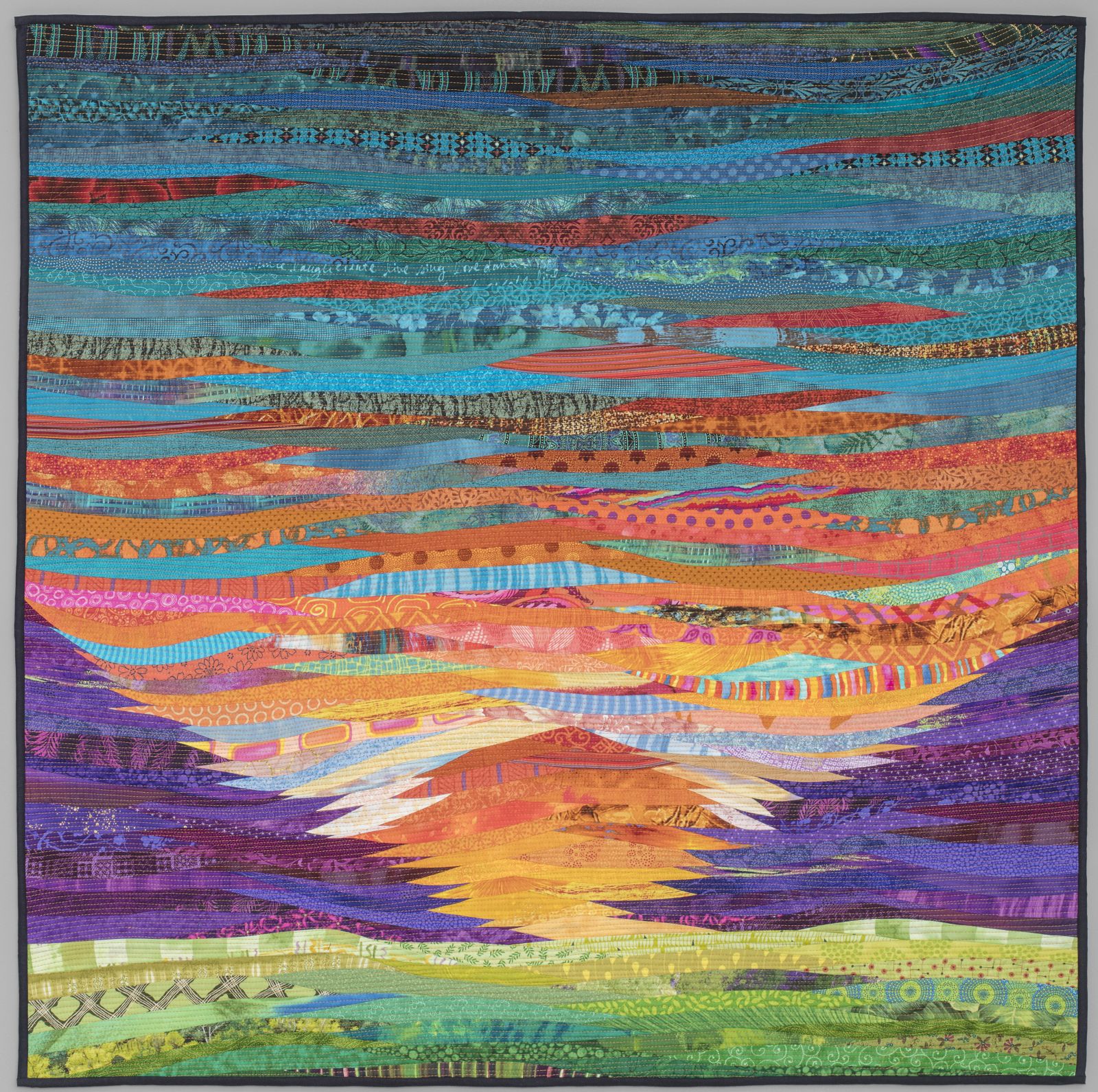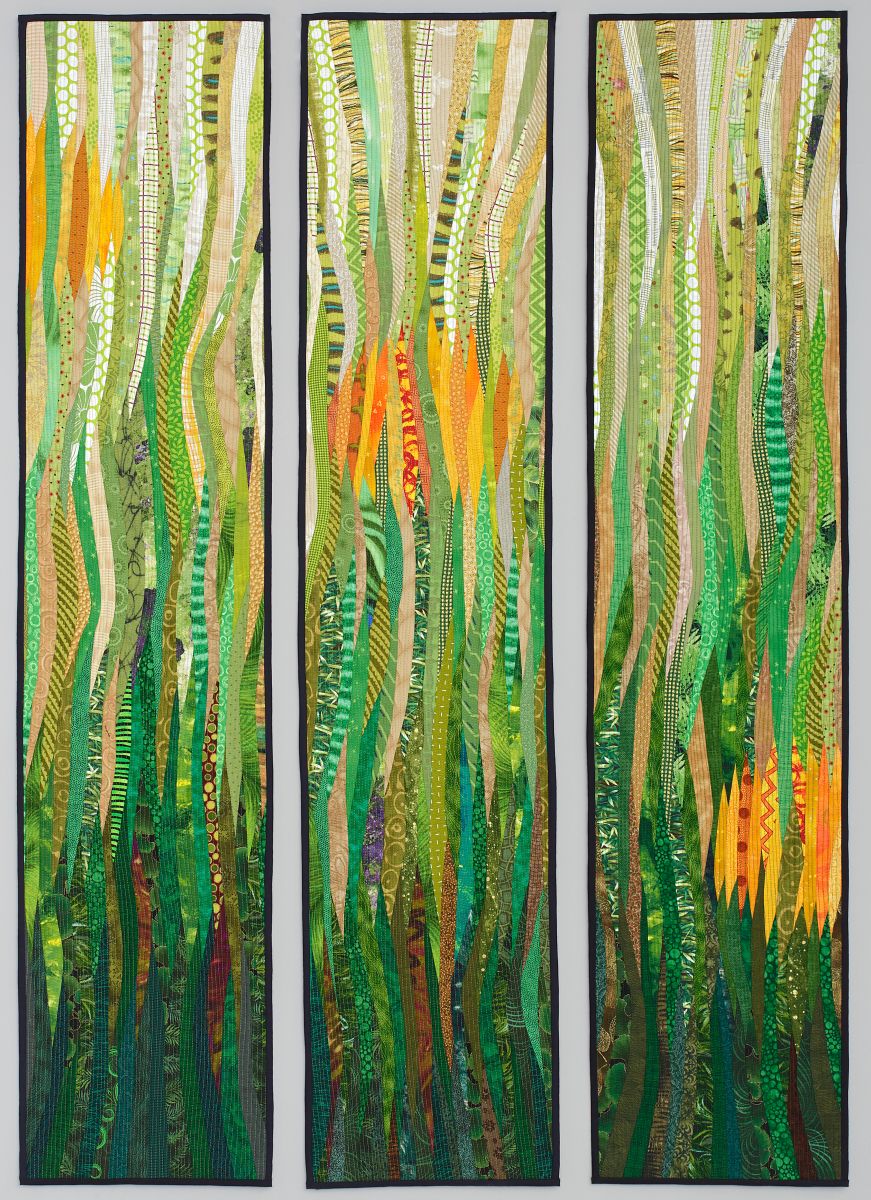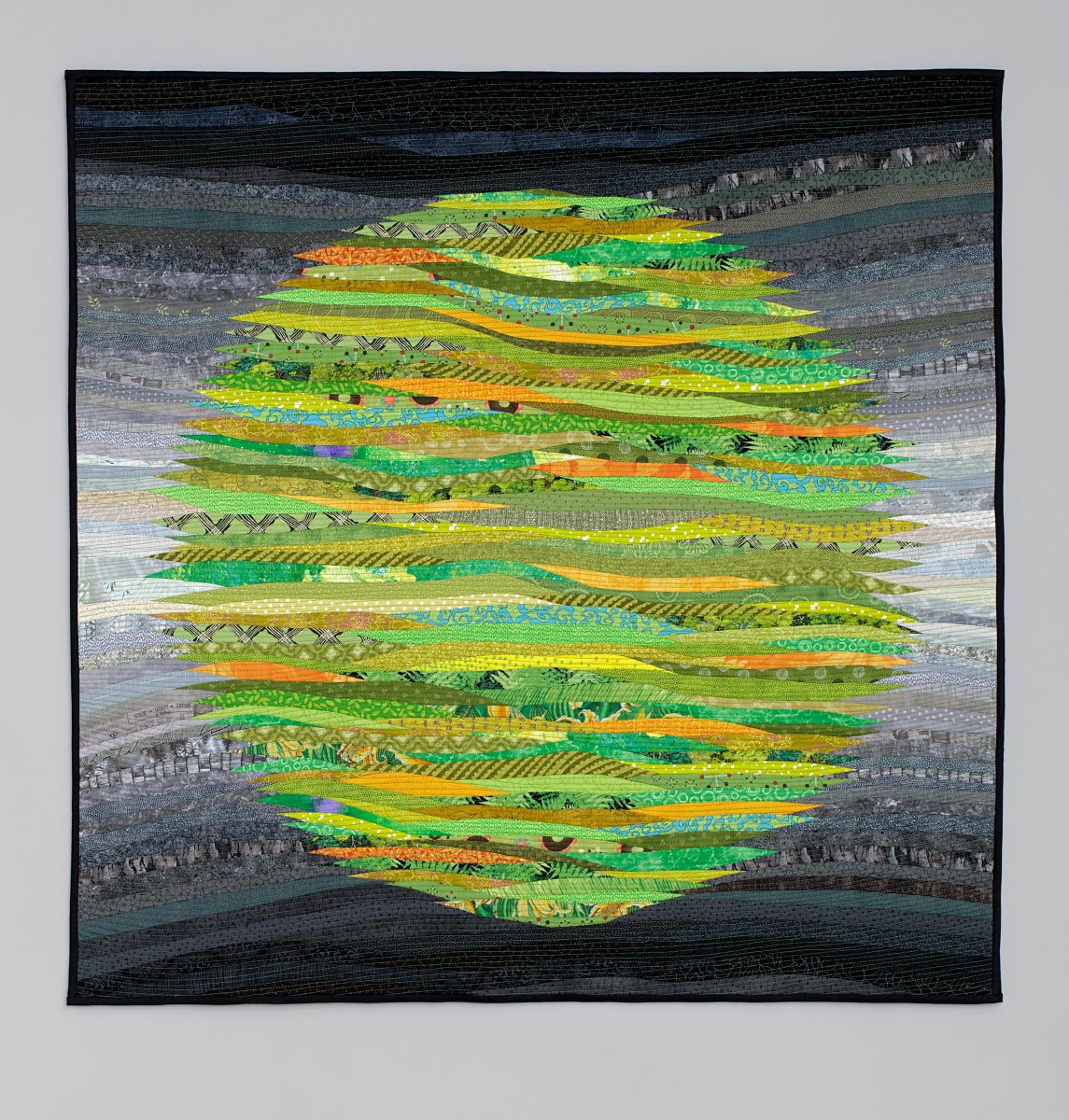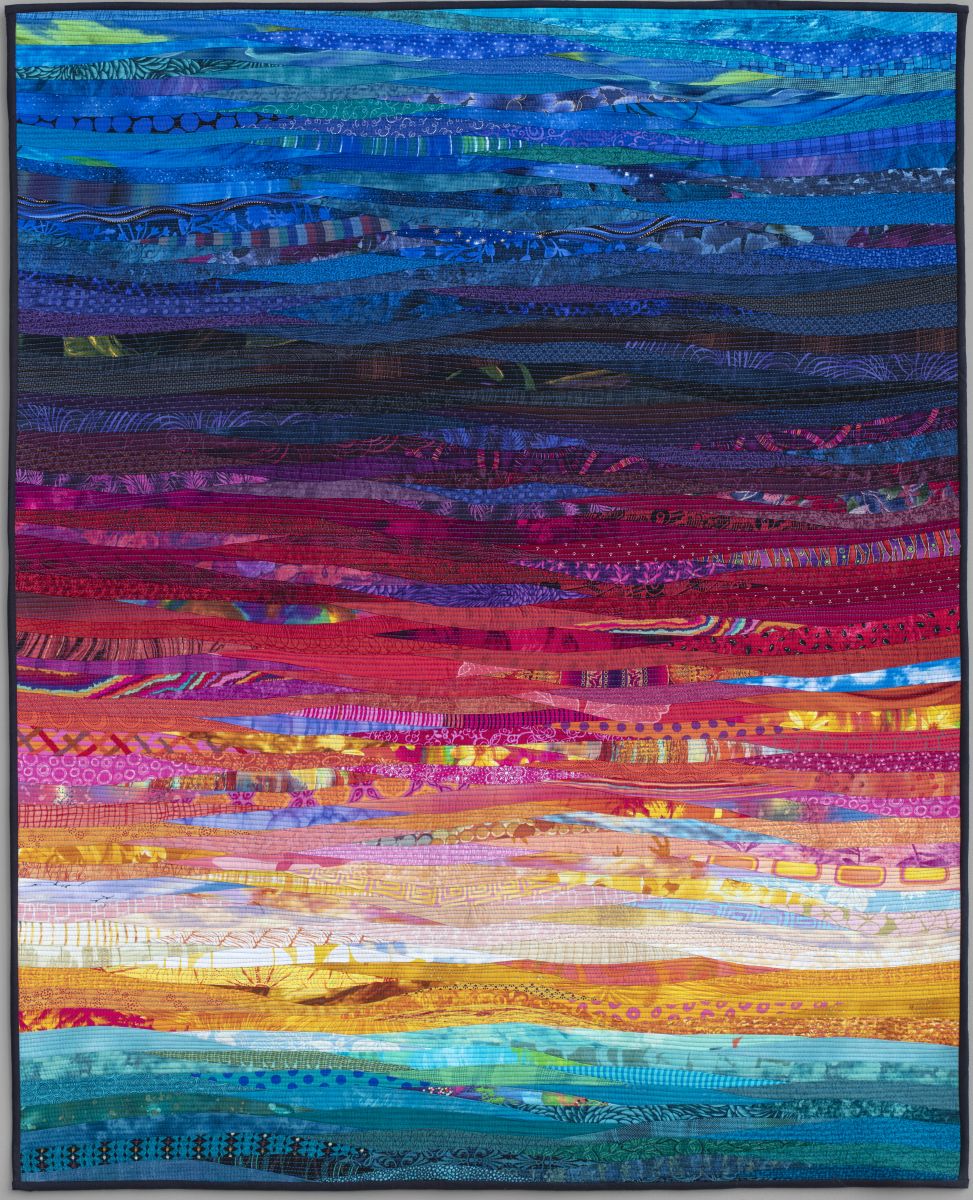SAQA Seminar - Unit 5
Artist Q&A Ann Brauer - Selling at Fine Craft Shows
What are some outlets where you show and sell your work?
Fine craft shows are an important component of my overall goal, which is to support myself making the quilts I want to make while also having fun doing it. My current plan is to do a number of craft shows that will allow me to introduce my work to customers and get feedback from others. In addition, I sell online and have an open retail studio where I can work and display my quilts. I do a few of the SAQA Regional exhibitions sell in a couple of galleries, and work with a few interior designers and decorators. In my mind, I try to see where each opportunity fits within this overall plan and also tweak the plan as the market and my life changes. This allows me to take personal responsibility for each show I do and lets me grow as an artist. Of course, this is an outline of my plan—research how others do it and create a plan for yourself that can change as your work changes.

Mountain Sunrise
Why do you do craft shows?
For the last 38 years, I have participated in various fine craft shows even though the cost can be significant—both the expense of actually doing the fair and the time involved in planning, setting up, selling, and then reestablishing the studio after the show. Listening to attendees and trying to answer their questions can be tiring. Loading in and loading out is physically tiring. Some of these attendees need to be educated about art quilts. And of course, there is the possibility that I don’t make expenses. So why do I keep doing these shows?
Often I am a better salesperson for my quilts. While customers will only purchase a work of art that they like, they also appreciate knowing the story behind the quilt. What was I thinking? What makes this quilt special? It is also fun talking about the quilt and discovering what others read into it which gives me added insights into my work. I can discuss possible variations of size and color more knowledgeably.
Of course, most people do not attend a craft show to purchase a quilt. However, I find it a great opportunity to introduce them to my quilts. What makes it special? Why might they want to consider it in the future? I try hard not to push the customer to purchase as those orders frequently come back to haunt me. And even if they never purchase I learn something from these people who are sincere lookers.
Not everyone loves my work. At a retail show, I am frequently part of the wallpaper. Many of the comments are harmless. Some want information about making a quilt “just like mine.” Or they just want to talk. There is nothing wrong with that. After all, it is better to have people in my booth than having it empty.
A few will make less pleasant comments. When I first started, a wise and more knowledgeable craftsperson taught me that shows offer a graduate education in marketing and selling my work if only I listen to what others are saying. One or two such comments are just luck of the draw. However, when everyone said that their seams were straighter than mine, I knew I had to change my work and make quilts where the seams were purposefully not straight. With the growing popularity of long arm machines, I needed to address that concern by adding machine quilting that worked for me although I still do the quilting on my 1965 Singer 281-3.
I began doing craft fairs shortly after I moved to western Massachusetts and decided to see if I could support myself making quilts. At that point, the craft fair circuit had been established for only a few years and the art quilt movement was just beginning. Although a few quilt makers were marketing innovative quilts, there was still a feeling among many quilt makers that it was almost sacrilegious to sell your work. I appreciated the more honest commercial aspect of the craft fair circuit. I began doing a few local shows to learn how to sell my work. A couple of years later, the American Craft Council moved one of its premier shows to West Springfield, Massachusetts, which was only an hour from my home. After visiting it, I realized that my work was appropriate to that market, I applied and was accepted.
Needless to say, I made every mistake in the book. Yes, I made myself a new booth of unpainted wood 2 x 4’s, but I lacked lights, a backdrop, and a rug. I still remember the galleries that walked by me and quietly laughed. Luckily my neighbors were very kind and helped me polish the booth. In addition, they offered me ideas for the future. Interestingly, the three galleries which decided to order from me liked my work enough they continued working with me until they went out of business.

Marsh Moon
How do you choose which shows to do?
Each show is different with new challenges and new marketing possibilities. To begin, I suggest that you try a few less expensive shows to see if this is a venue you think is appropriate for you. Do you like talking about your work? Do you like the interchange with the public? Can you deal with rejection? If so, then visit shows similar to those you are interested in, talk with the vendors during their quiet times, and determine if you would feel comfortable marketing your work at that show. Many of the promoters are always hunting for new vendors. Contact them and explain that this will be one of your first shows. A few of the major shows, including the American Craft Council, offer smaller booths for those just beginning to market their work. Others will guide you through the process of setting up your booth or connect you with artists in your area who can make suggestions or even mentor you. And take a deep breath. You will make mistakes. You can cope with them and even use the mistakes to your advantage.
There are lots of shows to choose from. One of your best sources of information is other craftspeople. Once you start doing shows, talk with your neighbors and ask for suggestions. What shows do they do? What do they think of the promoters? Is it worth the money?
Some promoters only do one show — it could be a benefit for a local museum or school. It could be a pop-up show at the holidays. Other promoters do a series of shows—again try to get a feel for the promoter and the shows. Do they draw in customers? Do they have a good reputation? Would your work be a good fit? How difficult is it to do the show? Will you need to get a hotel or other place to stay? How long is the show? Check out the website and see what you think of the other artists. Is there anyone you know who might give you a straight answer? And of course, if you can—visit the show and talk to the exhibitors, especially during quieter times at the show. I try to plan my shows for the year to include an assortment of shows that I have done before and shows where I can introduce customers to my work.
Most regional or national shows require submission of images. Often this is a set of four or five images that show the work you plan to exhibit. Some of these shows also request a booth image. When submitting your slides, try to keep the images crisp and clean with a simple backdrop. At the larger shows, the jurors are seeing a lot of images—it helps if you present a coherent statement of your work. Usually, the booth image should not include your name or other identifying information. Most of the major shows use either Zapplication or Juried Art Services, which can also be a good method of researching craft shows. Just follow the directions for uploading images and give yourself enough time to make sure your application is complete and presents your best work.
Another decision to make is whether you want to do outdoor shows. Some of this depends on the area where the show is. An outdoor show can have more people walking through. A few shows provide a large tent. For others, you will need to either rent a tent or purchase one. You will also need to figure out how to protect your work from the elements. Can you anchor the tent to the ground? Will you be comfortable leaving your quilts in the booth overnight or do you prefer to put them in your vehicle. How protected is the back of your booth?
Indoor shows are often more expensive. Customers frequently have to pay an admission fee to attend so there may be fewer people in the aisles. They also tend to be more seasonal. It may be harder to move your work into the space. While it can be hard to invest in a more expensive show, frequently these are the ones who have the customer base to support art quilts. That is why you want to determine if this particular show is right for you.

Green Circle
Do you have any tips for displaying your work?
For most shows, you need to figure out how to display your work. After all, you want to convey that you take your work seriously. A few shows provide you with a booth or even hard walls. Sometimes you can rent a booth. If you are going to be doing a lot of shows, it is often better to purchase a booth. Again there are lots of different booths out there. Before purchasing or making a booth, plan how you intend to display your work.
In my case, I purchased a booth with steel poles that break down to fit into my van. I also have fire-resistant curtains that hang on the booth. Because of the poles, I can fit into most booth spaces. It is also sturdy enough that it worked when I used to do outdoor shows or when I made larger bed quilts. However, it is heavy to carry and does require care in setting it up. I hang my work from the sides to display it. There are other units that take up more space in your van but allow you to pin the work to your booth. In addition, I use a couple of shelving units that I can take apart. Again the glass I use is heavy, and it requires time to assemble and take them apart but they don’t take up much space in my van. There are lots of other shelving units that are available.
If a show has electricity, then definitely use it. Make sure the cords are three-pronged. And bring a couple of spare light bulbs if possible. LEDs are great. I use track lights that are sold for trade shows. For some shows, having a rug adds to the overall effect. Again ask if this is needed. The rug will make the floor more comfortable on your feet. I keep a large black rug that I can use rolled up in a closet. Chairs are important—do you really want to stand for so many hours on a surface that may be hard. Many people use a high director’s chair so they can converse at eye level with customers. I use a folding chair that I can stand on when needed. I also bring a step ladder to help me set up the booth.

Courthouse Quilts
HINT: If you are purchasing a new booth, try setting it up before the show. That way you can see how it works and what problems you may encounter.
I currently pack my quilts in plastic boxes made to go underneath a bed that also fit in my van and protect the work. In the past, I have also rolled the quilts in plastic bags or boxes. I usually bring a small dolly to transport the work. Other things I bring are a credit card reader, a sales book, a notebook, and a selection of useful items—cash, scissors, tape, spare pens, pins, another pair of shoes, a jacket, water, etc. Do I need to bring bags? How will your customer display a quilt that they purchase? The list is long and will grow with experience. Most shows will tell you where you can purchase supplies that you forgot or maybe you can borrow from your neighbors.
Before the show, I read through the checklist that promoters give you to make sure I have ordered any services that I need, such as electricity. If needed, I book a space to stay. Do I need to get a new sales tax number? I try to promote the show to friends and followers using social media, word of mouth, and even snail mail. I also bring postcards that have an image of my quilts and contact information. After all, if I am going to spend time doing the show and discussing my work with people, I want them to be able to contact me when they are ready. This also helps my overall marketing plan—they may not purchase now but maybe later. Of course, I also try to double-check where the show is and make sure I arrive on time.
Setting up the booth is one of those hectic times. Tempers can easily fray as there is so much to do and so much pressure. I find it best to get to the booth as early as possible and try to proceed methodically. First I unload my van. Usually, I then have to move it to the approved parking space to make room for other exhibitors. I lay out the booth and try to get it up as calmly as possible. Usually, you are given a defined space to stay within.
Finally, the fun begins as I figure out how to best display the quilts. I want to have several that will draw the customers in. For my work, I also try to have items that customers can purchase without too much thought. Many quiltmakers make a selection of smaller quilts that are more affordable. I make some more affordable useful items that work as gifts. If you are creating smaller items, make sure they represent you well and will wear well. I find there is a balance that lets people engage in my booth without being overwhelmed. I will gladly get out additional stock for interested customers but too much visible stock can confuse shoppers.

Ocean Sunrise
What advice do you have for during the show?
You have paid money and time to be at the show. Try to make it worthwhile by acting in a professional manner. I stay in my booth as much as possible and greet customers as they come in and practice conveying the key aspects of your work that I want them to remember while also listening to their questions and concerns. Yes, you will be saying the same thing repeatedly but try to have it fresh. After all, this is the first time they have heard it. When they leave, thank them. I usually offer a card that tells them where they can find me online, at my studio, or at my next show.
Not everyone will stop at your booth — there is just so much to see at the show. If too many people are walking by, see if you can rearrange the booth to freshen it. Maybe your neighbors have ideas. Maybe you can hear comments from others. Maybe it is something to change for your next show. Make notes. Experiment. Have fun.
Even if the show is not good, try to be optimistic and upbeat. Unless the show is really slow, this is not the time to be reading a book or chatting on the phone with friends. Even with craftspeople, I try to get out of their way when they have a customer looking at their work. It is all right to design your next quilt or to make notes.
The end of the show is that time called “load out” when the mad dash to leave the show begins. As much as you want to get home, respect your fellow craftspeople and wait until closing time to begin packing up. I try to be as methodical as possible since there will be another show. Patience and a sense of humor are important. If you get a chance, thank the promoters for their efforts and make sure you have double-checked your area. When you get home, remember to pay your sales tax.
Has there ever been a disaster?
Craftspeople love to share the different challenges they have faced. I have survived blizzards, hail storms, power outages, a wind storm that split a large cherry tree in back of my booth. There was the year the first Gulf War happened during the show. The battery in my car has died just as I went to get it for load out. I had my brakes fail in the Lincoln Tunnel. My starter motor died in front of the Natural History Museum. My water pump has gone out as I pulled up to a show. (Hint—AAA can be a friend.)
I have driven a thousand miles each way for a first-year show that was in a bad part of town. That show was so bad that craftspeople were practicing yoga poses in the aisles on a Saturday afternoon (Yes, I had researched the show and knew the promoter. Mistakes happen.) I have forgotten my clothes, my backdrop, my lights, my postcards. I have had splitting headaches, bad colds, and the flu. I have sold next to nothing while my checkbook was basically empty. And of course, my studio floated down the river during Tropical Storm Irene while I was in Evanston, Illinois.
Always I was guided by the wise words that I learned a long time ago when I discovered that there was a huge support beam dominating my booth. I spoke with management, who replied quite succinctly “You are an artist. I am sure you will figure out how to deal with it.” I did and I do. There is always a Plan B, C, or D. You get the idea. After driving back from Evanston after I lost the studio I couldn’t think about my studio floating down the river. Instead, although I did not know what would greet me when I made it home, I forced myself to try to figure out what I could do next. One day at a time. One step at a time. I had a brand to maintain and having survived so many different disasters I knew that somehow I would cope. Of course, that did not prevent me from crying on the Interstate driving through Cleveland, Ohio when the traffic was whizzing by and there were no rest areas. There was nothing to do but keep going.
What are some of the drawbacks to participating in craft shows?
Of course, there are lots of drawbacks to this method of supporting myself. I am on the road enough that just as I get inspired, I may need to travel again to sell my work. In addition, I don’t always have the time to push my art as much as I would like. After all, since my goal is to sell my quilts, I need to have stock. This means that I can’t dedicate large amounts of time to one quilt. I used to secretly resent those that did not need to sell their quilts to survive. I am after all a bit competitive and would love to be in all the prestigious shows.
But I do get to be my own boss and work with fabric in my own studio almost every day. What more can I ask for, really? I also need to juggle my time and output. Is it more important to have more blue potholders or to finish that large quilt? When do I begin packing? I also need to keep my style recognizable while also pushing it. I find that it takes my audience a couple of years to catch up to changes in my work. They want to purchase the quilts that they have been dreaming about since they last saw them.
What have been some of your successes?
Probably one of my biggest successes is simply the fact that I keep going. What more can I ask for? I love the customer who had purchased a quilt 30 years ago and decided as she was retiring from her job that she needed to update her home by replacing that quilt with a new one from me. I also love the customers who can recognize my work after many years and countless changes in style. Of course, I also love the customers who purchase a new potholder every year from me. What an honor that they are spending some of their hard-earned money to buy something so simple but that gives them joy.
I enjoy the camaraderie of the shows. Retail customers gush if they like your work which feeds my artistic spirit. Many of the craftspeople I have met at the shows have become long term friends.
One of my greatest successes was doing a series of 12 quilts for the Federal District Court House in Springfield, Massachusetts. The space had been designed to display quilts. The people in charge knew my work from the fairs I had done in the area and asked me if I would be interested. There was only one answer—YES! I would make it work. And I did. Delivered the work on time to the site, and I’m still getting compliments from those who have seen the quilts.
Any final thoughts?
I never know what will happen on any day. Will I get a wonderful large order? Will I get into the craft shows that I want to do? As always is there that Plan B, C, or D if I don’t? However, for me, I am glad I chose this path.
If you are thinking of doing the same, try it. Do as much research as you can to make your plan your own and to have the answers as the market changes. And remember that life is too short not to enjoy what you are doing. Have fun and if it isn’t fun, there is always Plan B, C, or D.

